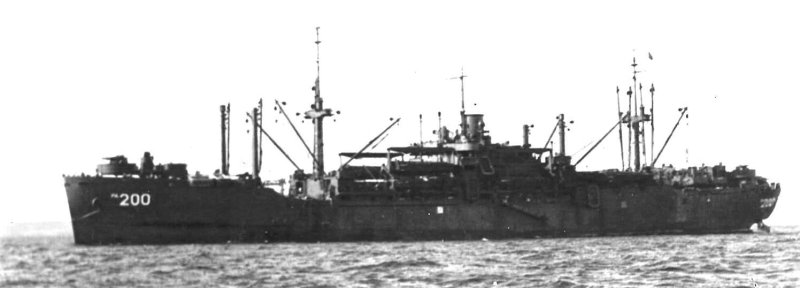
| Gators Page | APA 200 MARATHON | Hullnumber | Gators Page | ||
| Click here for Marathon Main Page | |||||

Laid down, 4 July 1944, as a Maritime Commission type (VC2-S-AP5) hull, under Maritime Commission contract (MCV hull 668) at Kaiser Shipbuilding Corp, Vancouver, WA.
Launched, 7 October 1944
Acquired by the Navy from the Maritime Commission on loan-charter, 27 October 1944
Commissioned USS Marathon (APA-200), 28 October 1944, CDR.. J. W. McElroy in command
During World War II USS Marathon was assigned to th Asiatic-Pacific Theater
Decommissioned, 8 May 1946
Struck from the Naval Register, date unknown
Returned to the Maritime Commission, 8 May 1946 for lay up in the National Defense Reserve Fleet, Suisun Bay, Benecia, CA.
Final Disposition, sold for scrapping, 18 April 1975, to Union Minerals and Alloys
USS Marathon received one battle star for World War II service
|
Named after a county in central Wisconsin.
Marathon (APA‑200), built under Maritime Commission contract, was laid down by the Kaiser Shipbuilding Co., Vancouver, Wash.; launched 7 October 1944; sponsored by Mrs. E. L. Greene; acquired by the Navy on loan charter 27 October 1944; and commissioned 28 October 1944, Comdr. J. W. McElroy in command.
Following shakedown exercises, Marathon underwent amphibious training operations off the southern California coast and in the Hawaiian Islands. On 24 January 1945, she departed Pearl Harbor, with army, marine, and naval passengers, and steamed independently for Espiritu Santo and Guadalcanal. She arrived in the New Hebrides 2 February, disembarked her army passengers and general cargo and continued on to the Solomons, arriving at Guadalcanal on the 7th. At the end of the month, the transport commenced a period of intensive amphibious exercises in preparation for the upcoming Okinawa campaign.
On 22 March she got underway for Ulithi, conducting gunnery drills en route, and 27 March sailed with the fleet for the Ryukyus. Just before dawn, 1 April, Marathon began dispatching her boats toward the beaches. Commencing with smoke boats, she continued unloading troops and cargo into the afternoon. losing only one of her landing craft, with no casualties, to enemy fire.
The transport remained in the assault zone until 5 April when she headed for the Marianas. From Saipan, she returned to Pearl Harbor, arriving on the 20th for maintenance. Following training, Marathon called at San Francisco to embark troops bound for Hawaii. She returned to Pearl Harbor 8 June and headed for the western Pacific 2 days later, steaming via Eniwetok and Ulithi, for Okinawa. Marathon reached that island 14 July and proceeded into newly named Buckner Bay, where she discharged passengers and cargo.
On 22 July, while at anchor in Buckner Bay Marathonís hull trembled with a force of a violent explosion. Postwar examination of Japanese records indicates that the explosion, which resulted in extensive damage, was caused by a kaiten, a one‑man suicide Japanese submarine, launched by I‑53.
Following prolonged repairs, on 16 September Marathon sailed to Nagasaki to embark ex‑POWs of varying nationality for transport to Okinawa. From October to February she swept minefields in the Nagoya, Hiro Wan, and Ise Wan areas.
Marathon headed for the United States in late February 1946. She decommissioned and returned to her owners at San Francisco 8 May.
Marathon received two battle stars for World War II service. Specifications: two LCMs
twelve LCVPs
three LCPUs one 5"/38 dual-purpose gun mount
four twin 40mm AA gun mounts
ten single 20mm AA gun mounts one Allis-Chalmers geared turbine
two Combustion Engineering header-type
boilers
one propeller
design shaft horsepower 8,500 |